Export from to CSV, JSON or XML
Posted by Kyle Hankinson August 9, 2023
export to CSV, JSON or XML
You can use
To export from a table or view, find the target in the database tree and right click on it. Choose 'Export as', then pick from either CSV, JSON or XML from one of the submenus.
Similar, when exporting from a results set either right click (or single click the arrow at the top left of resutls) and choose 'Export result set as' and pick from one of the options.
Video example:
Tags: MySQL Feature PostgreSQL Microsoft SQL Server SQLite Snowflake
Features
Posted by Kyle Hankinson August 9, 2023
Feature list
A list of some of SQLPro's features.
- Intellisense/SQL autocompletion
- Syntax highlighting with customizable themes (including dark)
- Tabbed based interface for an optimal user experience
- Context aware database tree navigation, including quick access to tables, views, columns, indexes and much more!
- SQL Beautifier/formatter
- Database wide searching
- NTLMv2 supported (but not required)
- Netbios support
- Master password support for additional security
- Supports Handoff from iOS to macOS
- Cloud support (Amazon RDS, Microsoft Azure, Heroku and many others)
- Support for multiple result sets at once
- Inline results editing
- Automatic foreign key detection
- No Java. SQLPro is native code
- Intuitive interface
- Import from CSV, JSON or XML
- Export to CSV, JSON or XML (link)
- Multiple cursor support (link)
- Execute query in cursor range (link)
Tags: Feature
Execute query in cursor range
Posted by Kyle Hankinson September 29, 2020

Disabled
When the option is disabled, no Current query background highlighting will occur. The Run query button will default to Run all and will not contain a Run current option.
Enabled (as default)
When enabled, the Current query will have a slight highlight. The Run query button will default to Run current, however the dropdown will contain a Run all option.
Enabled (but not default)
When enabled, the Current query will have a slight highlight. The Run query button will still default to Run all, however the dropdown will contain a Run current option.
Tags: Feature
Multi-cursors
Posted by Kyle Hankinson September 23, 2020
SQLPro supports multiple cursors. This allows a users to perform certain actions with fewer keystrokes.
There are two different ways available to select multiple cursors. The first, is by holding Option while dragging the mouse cursor up or down between lines.
The second method is by using the keyboard shortcut Command + Option along with ↑/↓.
Once multiple cursors have been selected, the following keyboard shortcuts are available.
←/→to move text selection to the left and right one character.Option+←/→to move text selection left/right one word.Shift+←/→to move and highlight text selection to the left and right.Shift+Option+←/→to move and highlight text selection left/right one word.Cmd+Deleteto delete from the curors beginnings to the end of the next word.Option+Deleteto delete from the curors beginnings to the end of the line.Shift+Option+Iturns selected text over multiple lines into multiple cursors.
Any feedback or issues with multi-cursor support should be added to the origional request ticket.
Tags: Feature
Server based results sorting
Posted by Kyle Hankinson August 12, 2020
Overview
Server based results sorting is a helpful and quick way for users to sort all results from a table without needing to write SQL. As of SQLPro v2020.71 is has been enabled by default. Using it is easy as can be. Simply click the header of a result set. The updated sort statement appear 'ghosted' in your query.

How to disable
Server based sorting can be disabled via the 'SQLPro' -> 'Preferences' menu item. Once the preferences dialog is visible uncheck the 'Server based results sorting'.

Notes
Server based sorting only works for simple queries. If the query is complex, then the results will be sorted locally using the 'in memory results'.